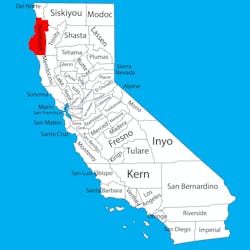An airport microgrid is moving forward on the far northern coast of California that could provide relief for planned utility power shutoffs and be a template for other, similar projects.
The Redwood Coast Airport Microgrid began about two years ago when Humboldt County’s Board of Supervisors gave the green light for the project to seek up to $5 million in funding from the California Energy Commission.
The project originated at the Schatz Energy Research Center (SERC), an affiliate of Humboldt State University’s Environmental Resources Engineering program. Other partners on the project include the county’s Public Works Aviation Division, Pacific Gas and Electric (PG&E) and the Redwood Coast Energy Authority (RCEA), which is a community choice aggregation.
SERC also took the lead in designing and implementing the microgrid at Blue Lake Rancheria, a Native American reservation in Humboldt County. The Redwood Coast Airport project was conceived as SERC was finishing up the microgrid for the casino and hotel at Blue Lake Rancheria, said Jim Zoellick, managing research engineer at SERC.
“We were wondering what to do next,” Zoellick said. “We had received funding through the California Energy Commission’s Electric Program Investment Charge, and knew there was another round of microgrids coming.”
EPIC, a $130 million a year ratepayer funded research project, has so far provided $84.5 million for 20 microgrid projects at 30 sites.
Isolated by mudslides and wildfires
Mudslides and wildfires sometimes close access to the two main highways to the region, and the Redwood Coast Airport becomes the only means of contact with the rest of the world. Not only does the region face isolating natural disasters, but it is also electrically remote. There are some local generating plants, but otherwise the area, which has a peak load of about 170 MW, is served by a single, 70 MW high voltage transmission line.
The idea of a resiliency microgrid made immediate sense to the team at SERC. But before it began considering the airport, it explored the idea of a microgrid for a hospital, fire house, health clinic and school, all located on the same block. That idea, however, proved too complicated because the same feeder also serves a residential neighborhood across the road. Moving the project forward would require securing individual permissions from each of the residents.
So instead, they began examining the airport, which is about seven miles north of Arcata. The team saw that it too could benefit from energy resiliency. “The airport is very critical for getting supplies into and around the area,” Zoellick said.
In addition to the airport, the microgrid will serve a neighboring Coast Guard station, a Federal Aviation Administration office, the community choice aggregator, a gun club and a dog shelter. In all, the microgrid will serve about 20 separate accounts. (The airport and Coast Guard facility each have multiple accounts.)
Testing complex model
That would add a lot of resiliency to the area, but it also complicates the development of the microgrid project. Many of the entities that would be served by the microgrid are customers of the community choice aggregator, the Redwood Coast Energy Authority. But PG&E provides the distribution service. To complicate matters further, at least one microgrid customer is a direct customer of PG&E.
To test contractual and regulatory concepts, the project’s partners created a community choice aggregation account for an electric vehicle charging station that then opted out of the aggregation. So, if the microgrid goes into island mode, separating from the grid, the community choice aggregator would be providing power to a PG&E customer.
An additional complication arises from a desire on the part of the community choice aggregation to sell energy and ancillary services into California’s wholesale power market.
So far, the airport microgrid project has been “making good progress and is on schedule,” Zoellick said. The first step, the design phase, is nearly 100% complete, he said. Tesla will be providing 2.4 MW of solar photovoltaic panels and a 2.2 MW/8.8 MWh battery storage unit that will be direct current (DC) coupled so that only one set of grid-facing inverters would be needed. This allows the project to save money on inverters that it will put toward a larger solar array, resulting in more energy per dollar invested, Zoellick said.
Airport microgrid explores tariffs
The California Energy Commission’s EPIC program puts a strong focus on pilot projects that can be replicated and provide a business model for future projects. Redwood Coast Airport Microgrid might serve this role in its exploration of microgrid tariffs.
Parties to the airport microgrid have been working on tariffs for the various relationships between the utility, the generation owner, and the various end-use customers.
Working with PG&E and consultants, the parties have developed three separate experimental tariffs that would guide the flow of revenue between the customer, the utility and the microgrid owner.
Redwood Coast Airport Microgrid presented the microgrid tariff ideas to the California Public Utilities Commission in a proceeding now underway to explore mechanisms to support microgrids. The tariffs include:
- The Microgrid Infrastructure Cost Recovery Tariff, which governs the recovery of cost for the utility to install and operate the microgrid
- The Islanded Grid Services Tariff, which determines compensation to the microgrid infrastructure funders and generation owners for helping to fund the grid
- The Islanded Energy Tariff, which lays out compensation to the generation provider for energy supplied while in island mode
By Who is Danny/Shutterstock.com
Zoellick says the parties have yet to reach a final decision on whether or not to file an experimental tariff with the PUC. Parties to the airport microgrid also are exploring other tariff or funding options with PG&E.
“PG&E is looking for ways to create resiliency hubs” in its territory, Zoellick said, particularly as the reality sets in of the wildfire shutoffs.
If the proposed experimental tariffs are used, one effect would be that they would establish a value for the microgrid’s resiliency — or at least serve as a proxy for the value of resiliency.
Under the business model being pursued, the Redwood Coast Energy Authority would be the generation owner and could fund the project in part by treating it as a generation project that would be covered through a ratebase charge on its customers.
“No matter how we do it, we are going to engage with the PUC,” Zoellick said. “It depends what makes sense and what adds value.”
Track news about airport microgrid projects. Subscribe to the free Microgrid Knowledge newsletter.







